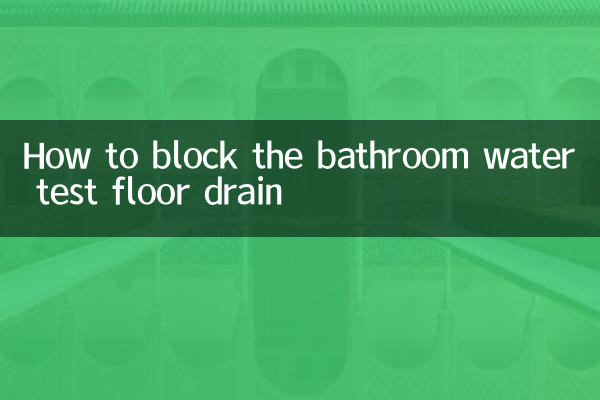How to block the water test floor drain in the bathroom
Testing a floor drain is a common step during home renovation or bathroom repairs. However, how to correctly plug floor drains to prevent water leakage is a headache for many people. This article will provide you with detailed solutions based on the hot topics and hot content on the Internet in the past 10 days.
1. Why do you need to plug the floor drain and test the water?

The purpose of plugging the floor drain and testing the water is to test the waterproofing effect of the bathroom. If the floor drain is not blocked, water will flow directly from the floor drain, making it impossible to detect leaks in other areas of the bathroom. The following are common reasons for testing a floor drain:
| Reason | Description |
|---|---|
| Check waterproof effect | Make sure there are no leaks in the waterproofing layer on the bathroom floor and walls |
| Check drainage system | Check whether the drainage pipe is clear and whether there is any blockage |
| Avoid water leakage hazards | Detect leaks in advance to avoid later repair costs |
2. Common methods of plugging floor drains
According to popular discussions on the Internet in the past 10 days, the following are several common methods for plugging floor drains:
| method | Operation steps | Advantages and Disadvantages |
|---|---|---|
| Plastic bag water method | Fill the plastic bag with water, tie it tightly and stuff it into the floor drain opening | Simple and easy, but the sealing performance is average |
| Tape sealing method | Cover the floor drain opening with multiple layers of waterproof tape or wide tape | Low cost, but may not be completely sealed |
| Special water blocking air bag | Purchase a special water-blocking air bag, insert it into the floor drain and inflate it | Good sealing, but additional tools are required |
| Cement temporary sealing | Temporarily seal floor drain openings with cement or plaster | Strong sealing, but later cleaning is troublesome |
3. How to choose the most suitable method for plugging floor drains?
When choosing a method to plug floor drains, consider the following factors:
| factors | Suggestions |
|---|---|
| The length of time to test the water | When testing water for a long time, it is recommended to use special water-blocking air bag or cement sealing |
| Floor drain type | Air bags are suitable for round floor drains, and tape or plastic bags can be used for square floor drains. |
| budget | If you have a limited budget, you can choose plastic bags or tape. If you have a sufficient budget, you can purchase special tools. |
4. Precautions during operation
1.Make sure floor drains are clean: Before plugging the leak, it is necessary to clean up the debris and hair around the floor drain to ensure the sealing effect.
2.Check tightness: After plugging the leak, pour a small amount of water, observe whether there is leakage, and then formally test the water.
3.Avoid damaging floor drains: When sealing with cement or plaster, be careful not to drop material into the pipe.
4.Testing time: It is generally recommended to test the water for 24-48 hours and observe whether there are signs of water seepage downstairs or in adjacent rooms.
5. Tips for plugging leaks hotly discussed by netizens
According to recent hot discussions on social platforms, here are some practical tips shared by netizens:
| coup | Source |
|---|---|
| Use balloons instead of water-blocking airbags | Shared by Douyin home experts |
| Old towel + plastic bag combination to stop leaks | Xiaohongshu DIY guide |
| Plasticine temporary sealing | Zhihu high praise answer |
6. Suggestions from professional waterproofing masters
After interviewing many professional waterproofing masters, they gave the following suggestions:
1. When testing the waters for new house decoration,Prioritize the use of professional water blocking tools, to ensure that the test results are accurate.
2. When repairing an old house, if the floor drain has a special structure,Contact property management or professional maintenance personnelAssist with processing.
3. After the water test is completed,Be sure to clean the sealing material thoroughly, to avoid causing pipe blockage.
7. Frequently Asked Questions
| question | Answer |
|---|---|
| Can it still be drained after the leak is plugged? | It must be completely blocked during the water test, and the drainage function must be restored immediately after the test is completed. |
| What should I do if I test the water and find a leak? | The original waterproof layer needs to be eradicated and waterproofed again. |
| The floor drain is blocked too tightly and cannot be removed? | You can try to use a hook or suction cup tool to assist in removing it. Do not disassemble violently. |
Summary:Plugging the floor drain when testing the water in the bathroom is a key step in the waterproof test. By choosing the appropriate method according to the actual situation and paying attention to the operational details, you can effectively detect the waterproofing quality of the bathroom. It is recommended to save the various methods mentioned in this article for emergencies.

check the details

check the details